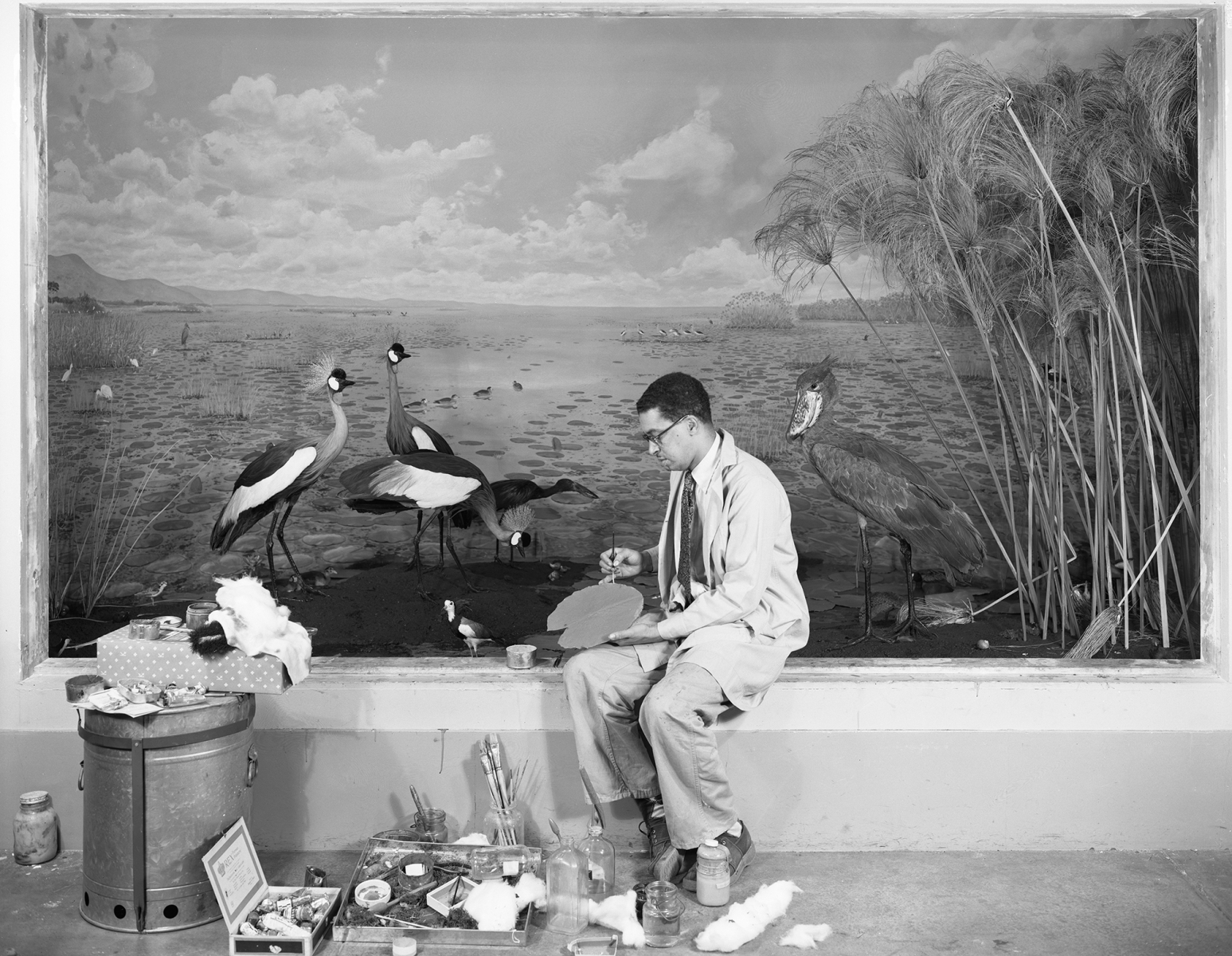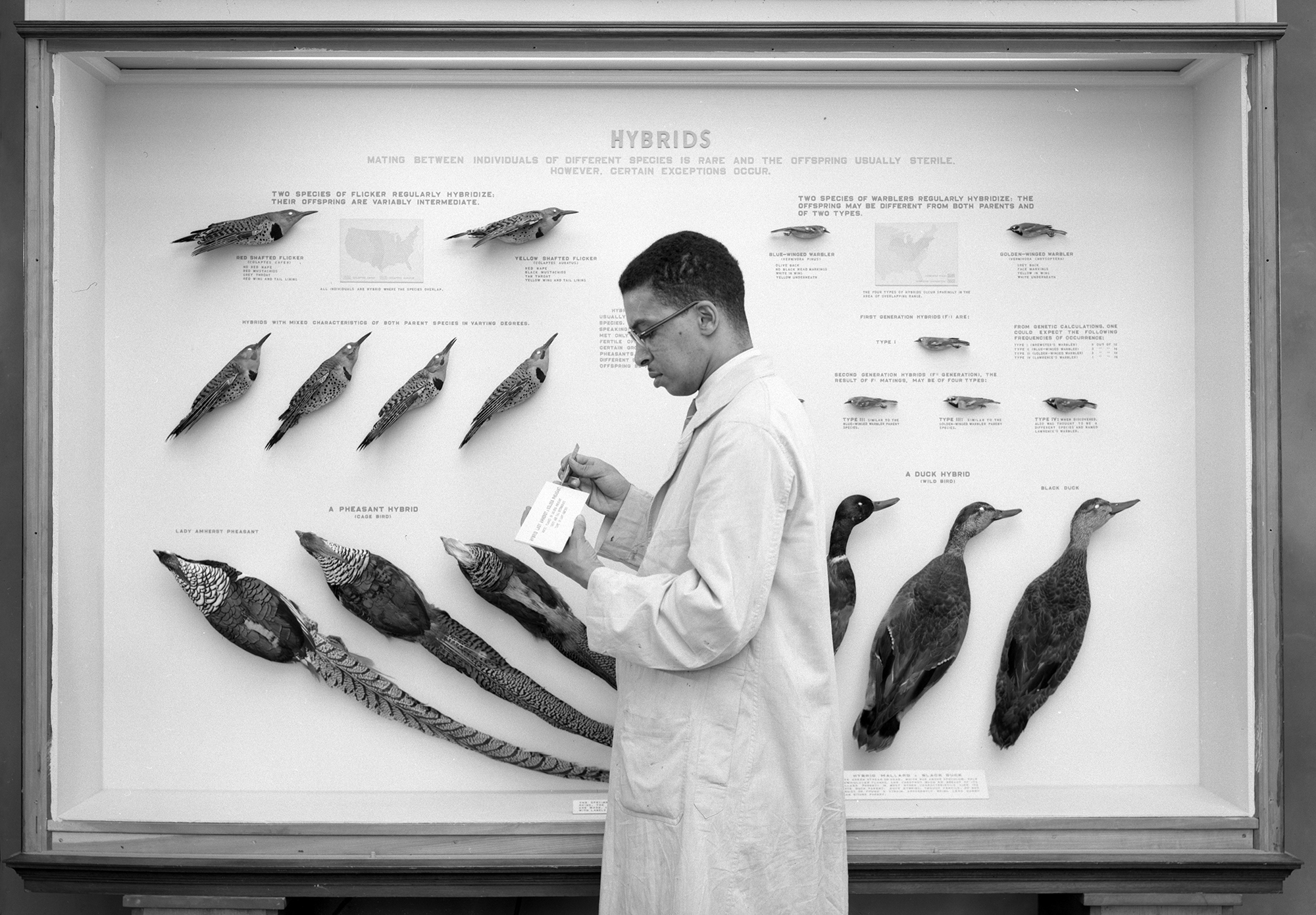From the late ’40s to the early ’70s, Carl Cotton preserved, mounted, and restored thousands of specimens across the Field Museum and beyond.
Now, nearly 50 years after Cotton’s passing, the museum is honoring the man who was its first black taxidermist. A Natural Talent: The Taxidermy of Carl Cotton, which is part of the museum’s first official celebration of Black History Month, offers a glimpse of the artist who brought so much of the museum to life.
Exhibition developer Tori Lee decided to focus the museum’s first Black History Month exhibition on Cotton after her colleague Reda Brooks spotted a photo of him with the Marsh Birds of the Upper Nile diorama in one of the Field’s recent anniversary publications.
“She did a double take because it was so unexpected to see an African American man here at the Field Museum in the ’40s, and in that kind of role,” Lee says. “I felt this intense [desire to know], How did he get here?”
It wasn’t easy retracing Cotton’s life and work. Lee says that just a few other staff members in the museum were aware of him and his work when she launched into her research. But in collaboration with Cotton’s remaining family members, Lee was able to piece together a portrait of a passionate man with a deep love for nature and art. With help from the Field’s archival photos, records, and staff, Lee was able to identify the majority of the specimens Cotton stuffed and maintained. For the duration of the exhibit, which runs through October 5, stickers identify all (ordinarily unattributed) display cases that Cotton had a hand in creating.

Photo: Courtesy of the Field Museum
Born in 1918, Cotton grew up in Washington Park. By the recollection of historian and civil rights activist Timuel Black, who was a close childhood friend, Cotton began practicing taxidermy at a young age, stuffing squirrels, birds, and, eventually, house pets brought to him by neighbors who sought to memorialize their companions.
“To preserve the image of other life besides human life — knowing him as a friend, that is what he intended,” Black recounted in a video interview displayed at the exhibit.
Cotton first sent a letter to the Field seeking employment as a taxidermist in 1940 but was politely turned down. The taxidermy department didn’t have any vacancies, then–museum director Clifford Gregg wrote, and besides, he added, it was “practically a uniform requirement” for staff members to have a doctorate or a professional reputation — neither of which 22-year-old Cotton had.
In 1947, after he had returned from naval service in World War II, Cotton once again reached out to the Field, this time asking to volunteer with the taxidermy staff and to receive instruction in a special method of preserving fish and reptiles.
“For years taxidermy has been my main interest and hobby,” Cotton wrote in a letter postmarked from his home at 362 West 59th Street. “My ambition is… not doing just ‘average’ taxidermy but turning out work comparable to that of [current Field taxidermists] Carl Akeley, Leon Pray, Leon Walters and other artists.”
By all accounts, Cotton was an exceptional taxidermist. This was apparent to Field staff just weeks after he joined the taxidermy department as a temporary assistant in the fall of 1947. “Mr. Carl W. Cotton … proves so satisfactory in every way that we wish to use him full time in that [zoology] division. Mr. Cotton brings enthusiastic interest and willingness to work,” chief curator of zoology Karl P. Schmidt wrote.
Most taxidermists at the time specialized in one class of animals; Cotton started out working with birds, ultimately preparing a quarter of all the birds perched in the museum’s bird hall. But Cotton proved his versatility early on, preparing mammals, reptiles, and eventually even insects and salmon for display. (Fish are considered among the most complex animal groups to taxidermy because their skin loses color as soon as it dries out. Typically, scales must be repainted by hand or entirely recreated, depending on the type of fish.)
By 1966, Cotton had become the first staff member of the museum’s new exhibitions department, which took over responsibility from individual departments for designing and creating exhibits. The appointment gave him the freedom to curate a variety of displays across the museum.
Video: Courtesy of the Field Museum
Throughout his career at the Field, Cotton continued practicing taxidermy at home. When he and his family lived in Gary in the ’50s and ’60s, he used a built-out part of their garage as his personal lab; when Cotton moved back to Chicago shortly before his death in 1971, he used the bathroom in his small Bronzeville apartment. Carl Donn Harper, one of Cotton’s grandchildren, says that his freezer was always full of animals waiting to be preserved and stuffed.
“Everything was in there — bear skin rugs, fish that he had caught that he decided he was going to work on and keep,” Harper recalls. “My mother would take me by, and while the adults would be up front, having coffee and talking, I’d be in the back exploring.”
Some of these animals throughout the years were for himself or for friends, but many were outside commissions. It wouldn’t be uncommon for larger animals to remain in the house in some stage of preservation for extended periods. Ruthye Cotton-Fordham, Cotton’s youngest daughter, was only two or three when her father passed away, but she says that her older sisters told stories of a deer that got dropped off at the Playboy Mansion sometime in the 1950s.
“It was normal to us,” Cotton-Fordham says. “We could smell it and see him doing the [taxidermy] work.”
However, Cotton would never let the kids watch for more than a few seconds, as to limit their exposure to toxins like formaldehyde solution or arsenic. (The latter was used to prepare skins until the 1970s and ’80s.) Cotton-Fordham suspects that repeated exposure to chemical fumes may have led to the cancer that caused her father’s early death at 53.
Lee, the exhibit’s curator, says she hopes that learning about Cotton would expand what people and especially kids of color think is possible.
“I want people to feel like they can work here [at the Field], that they can do different things that may seem weird to other people, or things that they didn’t even know existed,” she says.
Harper, Cotton’s grandson, agrees.
“I think it’s important to the city and to the kids to know that there’s a black man who did this, and as part of black history, we need to know more about it,” Harper says. “We’re very proud as a family. The thing about it is, his work has been there all along. People just didn’t know it.”



